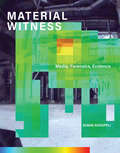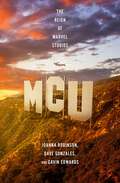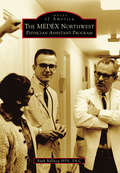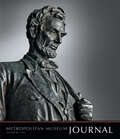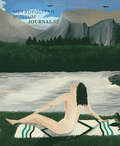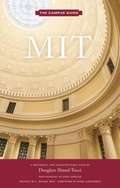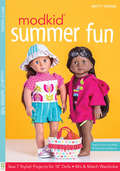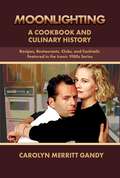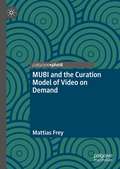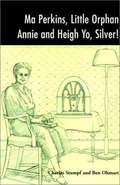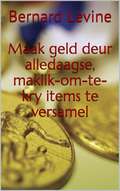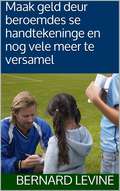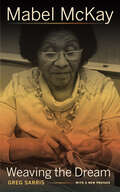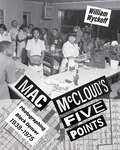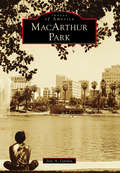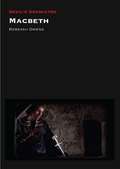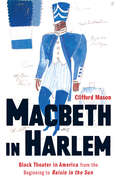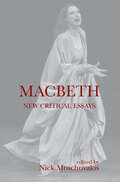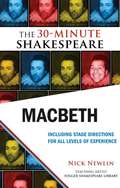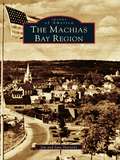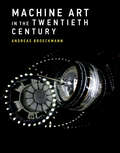- Table View
- List View
MATERIAL WITNESS: Media, Forensics, Evidence (Leonardo)
by Susan SchuppliThe evidential role of matter—when media records trace evidence of violence—explored through a series of cases drawn from Kosovo, Japan, Vietnam, and elsewhere.In this book, Susan Schuppli introduces a new operative concept: material witness, an exploration of the evidential role of matter as both registering external events and exposing the practices and procedures that enable matter to bear witness. Organized in the format of a trial, Material Witness moves through a series of cases that provide insight into the ways in which materials become contested agents of dispute around which stake holders gather.These cases include an extraordinary videotape documenting the massacre at Izbica, Kosovo, used as war crimes evidence against Slobodan Milošević; the telephonic transmission of an iconic photograph of a South Vietnamese girl fleeing an accidental napalm attack; radioactive contamination discovered in Canada's coastal waters five years after the accident at Fukushima Daiichi; and the ecological media or “disaster film” produced by the Deep Water Horizon oil spill in the Gulf of Mexico. Each highlights the degree to which a rearrangement of matter exposes the contingency of witnessing, raising questions about what can be known in relationship to that which is seen or sensed, about who or what is able to bestow meaning onto things, and about whose stories will be heeded or dismissed.An artist-researcher, Schuppli offers an analysis that merges her creative sensibility with a forensic imagination rich in technical detail. Her goal is to relink the material world and its affordances with the aesthetic, the juridical, and the political.
MCU: The Reign of Marvel Studios
by Gavin Edwards Joanna Robinson Dave GonzalesMarvel Entertainment was a struggling toymaker not even twenty years ago. Today, Marvel Studios is the dominant player both in Hollywood and in global pop culture. But what accounts for its stunning rise? In MCU, beloved culture writers Joanna Robinson, Dave Gonzales, and Gavin Edwards draw on more than a hundred interviews with actors, producers, directors, and writers to present the definitive chronicle of Marvel Studios and its sole, ongoing production, the Marvel Cinematic Universe. As they delve into the studio's key moments - from the contentious hiring of Robert Downey Jr. for Iron Man to the negotiations over Disney's acquisition of Marvel to studio head Kevin Feige's embrace of streaming TV - the authors demonstrate that the genius of Marvel was its resurrection and modification of Hollywood's old studio system. Dishy and authoritative, MCU is the first book to tell the Marvel Studios story in full - and an essential, effervescent account of popular culture.(P) 2023 Recorded Books
MCU: The Reign of Marvel Studios
by Gavin Edwards Joanna Robinson Dave GonzalesMarvel Entertainment was a struggling toymaker not even twenty years ago. Today, Marvel Studios is the dominant player both in Hollywood and in global pop culture. But what accounts for its stunning rise? In MCU, beloved culture writers Joanna Robinson, Dave Gonzales, and Gavin Edwards draw on more than a hundred interviews with actors, producers, directors, and writers to present the definitive chronicle of Marvel Studios and its sole, ongoing production, the Marvel Cinematic Universe. As they delve into the studio's key moments - from the contentious hiring of Robert Downey Jr. for Iron Man to the negotiations over Disney's acquisition of Marvel to studio head Kevin Feige's embrace of streaming TV - the authors demonstrate that the genius of Marvel was its resurrection and modification of Hollywood's old studio system. Dishy and authoritative, MCU is the first book to tell the Marvel Studios story in full - and an essential, effervescent account of popular culture.
MCU: The Reign of Marvel Studios
by Gavin Edwards Joanna Robinson Dave Gonzales"A superb chronicle of how Marvel Studios conquered Hollywood…. This definitive account of the Hollywood juggernaut thrills." —Publishers Weekly, starred review The unauthorized, behind-the-scenes story of the stunning rise—and suddenly uncertain reign—of the most transformative cultural phenomenon of our time: the Marvel Cinematic Universe. Marvel Entertainment was a moribund toymaker not even twenty years ago. Today, Marvel Studios is the dominant player both in Hollywood and in global pop culture. How did an upstart studio conquer the world? In MCU, beloved culture writers Joanna Robinson, Dave Gonzales, and Gavin Edwards draw on more than a hundred interviews with actors, producers, directors, and writers to present the definitive chronicle of Marvel Studios and its sole, ongoing production, the Marvel Cinematic Universe. For all its outward success, the studio was forged by near-constant conflict, from the contentious hiring of Robert Downey Jr. for its 2008 debut, Iron Man, all the way up to the disappointment of Ant-Man and the Wasp: Quantumania and shocking departures of multiple Marvel executives in 2023. Throughout, the authors demonstrate that the original genius of Marvel was its resurrection and modification of Hollywood’s old studio system. But will it survive its own spectacular achievements? Dishy and authoritative, MCU is the first book to tell the Marvel Studios story in full—and an essential, effervescent account of American mass culture.
MEDEX Northwest Physician Assistant Program, The (Images of America)
by Ruth Ballweg MPA PA-CThe MEDEX Northwest Physician Assistant Program was created at the University of Washington in 1968 as one of the nation's first physician assistant (PA) programs. A joint project of the Washington State Medical Association and the University of Washington School of Medicine, MEDEX was designed to meet the needs of overworked physicians in rural communities. As envisioned by MEDEX founder Dr. Richard A. Smith, "Physician Assistants were created by physicians, for physicians." Initially, all MEDEX students were former military corpsmen returning from Vietnam. Based on their extensive clinical experience, they were well accepted by doctors and their patients. Dr. Richard Smith was a former Peace Corps physician and leader of the federal project to desegregate the US hospital "system" as a requirement for Medicare reimbursement. Dr. Smith's founding principles for MEDEX included a collaborative model for community and practitioner involvement--the framework for the MEDEX Program throughout its 45-year history.
MET vol 48 num 1
by The University of Chicago PressThis is volume 48 issue 1 of Metropolitan Museum Journal. Founded in 1968, the Metropolitan Museum Journal is a blind, peer-reviewed scholarly journal published annually that features original research on the history, interpretation, conservation, and scientific examination of works of art in the Museum’s collection. Its scope encompasses the diversity of artistic practice from antiquity to the present day. The Journal encourages contributions offering critical and innovative approaches that will further our understanding of works of art.
MET vol 52 num 1
by The University of Chicago PressThis is volume 52 issue 1 of Metropolitan Museum Journal. Founded in 1968, the Metropolitan Museum Journal is a blind, peer-reviewed scholarly journal published annually that features original research on the history, interpretation, conservation, and scientific examination of works of art in the Museum’s collection. Its scope encompasses the diversity of artistic practice from antiquity to the present day. The Journal encourages contributions offering critical and innovative approaches that will further our understanding of works of art.
MIT: An Architectural Tour
by L. Rafael Reif Mark Jarzombek Douglass Shand-Tucci John HornerThe Massachusetts Institute of Technology (MIT) was founded in 1861 as the cornerstone of Copley Square in Boston's Back Bay, then the center of a progressive, proto-globalist Brahmin culture committed to intellectual modernism and educational innovation. MIT founder William Barton Rogers's radical vision to teach by "mind and hand" was immediately successful.In 1916 MIT, growing by leaps and bounds, moved its campus to the nearby Charles River Basin in Cambridge, where it now stretches along the shore overlooking the Back Bay. MIT: The Campus Guide presents the history of the Institute's founding and its two campuses. Today, the campus is studded with buildings designed by noted architects such as William Welles Bosworth, Alvar Aalto, Eero Saarinen, I. M. Pei, Steven Holl, Charles Correa, J. Meejin Yoon, Frank Gehry, and Fumihiko Maki, among others. Alongside the architecture is a distinguished array of public art including works by Picasso, Henry Moore, Alexander Calder, Louise Nevelson, Frank Stella, Sol LeWitt, and Jaume Plensa.
MODKID Summer Fun: Sew 7 Stylish Projects for 18" Dolls, Mix & Match Wardrobe
by Patty YoungThe bestselling author of Patternless Sewing Mod Style guides you through stitching cute and affordable warm weather designs for your dolls. Patty Young, of ever-popular MODKID®, debuts her newest collection of vacation outfits and accessories for 18&” dolls in MODKID® Summer Fun. Featuring fashionable details like ruching, gusseted pockets, and gathers, the full-size patterns come in a handy pattern pack format (and can be downloaded to your computer), including an easy-to-follow instruction booklet. From a swimsuit and cover-up to a sleeping bag and beach tote, these miniature designs are simple to make and stylish to boot! &“The perfect addition to your collection if you have a child or know anyone who has a child with a love of 18-inch dolls . . . Patty&’s book is full of colored images, detailed instructions, and creative projects that fit the needs of every 18-inch doll across the globe. If you are familiar with Modkid patterns, these will not disappoint in the clarity and style you have come to expect. I love that many of the designs in this book have a kid-sized counterpart available off the rack or in PDF patterns.&”—Pattern Revolution
MOONLIGHTING: Recipes, Restaurants, Clubs, and Cocktails featured in the iconic 1980s series
by Carolyn Merritt GandyEnjoy a cookbook that is inspired by the 80s television series Moonlighting with recipes, history, and lots of pictures of Bruce Willis and Cybill Shepherd. Some walk by night, some fly by day! Channel your inner Maddie Hayes and David Addison and prepare over 75 recipes inspired by the iconic 1980s Emmy-award winning television series Moonlighting. Moonlighting: A Cookbook and Culinary History - Recipes, Restaurants, Clubs, and Cocktails Featured in the Iconic 1980s Series has something for everyone. Fans of the show will recognize many of the recipes from the series - from cocktails such as Kamikazes in "The Pilot" and Vicious Virgins in "Big Man on Mulberry Street" to main courses including Petruchio's Ribs in "Atomic Shakespeare" and Steak a la Dave in "A Tale in Two Cities". These recipes are fun, easy to follow, and let you bring a little Moonlighting, starring Bruce Willis and Cybill Shepherd, into your kitchen and home! From appetizers and cocktails, to main dishes and desserts, each chapter includes recipes inspired by the show. It also includes classic stills, iconic quotes, and a history of the retro filming locations for the show's hotel, restaurant, and club scenes. This book is a must-have for all Moonlighting fans and for anyone interested in the food and culture of the 1980s.
MORI Building: The Making of Vertical Garden Cities
by Minoru MoriFrom building office blocks in the charred ruins of post-war Tokyo to creating Japan's largest ever urban development, Mori Building Co. has revolutionized how cities are made. In the late 1960s, after the success of its early 'number buildings', the company changed its focus from individual sites to whole neighbourhoods as Japan's economic miracle fuelled a building boom. By the 1980s Mori had completed the groundbreaking redevelopment at Ark Hills, home to the country's first 'intelligent building' which became Tokyo's international finance hub. This was the forerunner to the Roppongi Hills project - a cultural quarter which has attracted 40 million visitors a year since it was completed in 2003 and is Japan's biggest private development to date.In this book, Minoru Mori tells the story of the remarkable growth and pioneering vision that made Mori Building Co. Japan's leading developer. He traces the entire history of the company and shows how the unconventional thinking championed by Mori will be vital as Japan faces the challenges of recovering from a devastating tsunami while dealing with a shrinking population and a turbulent global economy.
MUBI and the Curation Model of Video on Demand
by Mattias FreySubscription video on demand (SVOD) represents the fastest-growing means to consume films and series. Although market leaders Netflix and Amazon Prime have received much scholarly attention for the way that they use algorithms and big data to connect users to content, there is another significant, relatively unexamined model: curation-style services such as BFI Player, IFC Unlimited, the Criterion Channel or MUBI — the latter, which forms the focus of this book, claims to be the world's most subscribed independent video on demand service. These platforms take advantage of common anxieties about algorithms, cultural surplus and filter bubbles to promote discovery, human-generated recommendations and quality over quantity of content. Deploying an original, holistic methodology that includes analysis of technological affordances, marketing rhetoric, business models, interviews with company executives and a qualiquantitative audience study, this book critically analyses MUBI as a way to understand this particular mode of content aggregation, cultural recommendation, choice architecture and community building. Curation services address a real, but decidedly circumscribed gap in the market. Ultimately, MUBI offers film, media and business scholars an instructive example of the fate of art cinema and media diversity in a digital culture increasingly dominated by a few giant tech companies.
Ma Perkins, Little Orphan Annie and Heigh Yo, Silver!
by Ben Ohmart Charles StumpfDo you know that one of old-time radio's best-known voices is heard as Cruella DeVille in Disney's One Hundred and One Dalmatians? You will find many interesting tidbits about the shows and the people who played in them.
Maak geld deur alledaagse, maklik-om-te-kry items te versamel
by Bernard Levine Leron TherouxWaar kry jy gewilde versamelitems wat verniet weggegee word (of wat teen lae pryse verkoop word), waarmee jy kan woeker vir groot winste? Hoe weet jy wat die waarde van jou versamelstukke werd is? Watse unieke goedjies kan jy begin versamel?
Maak geld deur beroemdes se handtekeninge en nog vele meer te versamel.
by Bernard Levine Leron TherouxJy kan geld maak deur boeke, gratis handtekeninge, kroeg-biermatjies en selfs doringdraad te versamel!
Mabel McKay: Weaving the Dream
by Greg SarrisA world-renowned Pomo basket weaver and medicine woman, Mabel McKay expressed her genius through her celebrated baskets, her Dreams, her cures, and the stories with which she kept her culture alive. She spent her life teaching others how the spirit speaks through the Dream, how the spirit heals, and how the spirit demands to be heard.Greg Sarris weaves together stories from Mabel McKay's life with an account of how he tried, and she resisted, telling her story straight—the white people's way. Sarris, an Indian of mixed-blood heritage, finds his own story in his search for Mabel McKay's. Beautifully narrated, Weaving the Dream initiates the reader into Pomo culture and demonstrates how a woman who worked most of her life in a cannery could become a great healer and an artist whose baskets were collected by the Smithsonian.Hearing Mabel McKay's life story, we see that distinctions between material and spiritual and between mundane and magical disappear. What remains is a timeless way of healing, of making art, and of being in the world. Sarris’s new preface, written expressly for this edition, meditates on Mabel McKay’s enduring legacy and the continued importance of her teachings.
Mac McCloud's Five Points: Photographing Black Denver, 1938–1975
by William WyckoffThis stunning collection of images celebrates the remarkable career of Burnis “Mac” McCloud, Denver’s premiere Black photographer between 1950 and 1980. His remarkable photographs, focused on Denver’s Five Points community, captured the ordinary lives of African Americans during a period that witnessed the end of Jim Crow segregation and the beginning of the Civil Rights era.Assembled from more than one hundred thousand negatives that McCloud left behind, this collection introduces his creative work to the world beyond the Mile High City. Author William Wyckoff also tells McCloud’s life story, revealing the challenges to and vitality of Denver’s Black community. At a time when much of what McCloud photographed is being swept away by gentrification and urban change, this collection of images preserves a time and place important not only for Denver but for all of Black America.
MacArthur Park
by Jose A. GardeaKnown as Westlake Park for its first 60 years, MacArthur Park is considered one of Los Angeles's original parks. Throughout its history, it has endured countless challenges as the neighborhood and city that surround it grew to become the current metropolis. Born out of progressive vision and drought, MacArthur Park, due to its elegant design and cultural programming, has been referred as a "civic jewel" and the West Coast version of Central Park. Like many urban parks, it has also been burdened with a negative image due to its many decades of neglect, crime, and municipal disinvestment. Today, MacArthur Park has survived as a critical green and cultural space for one of the most densely populated neighborhoods in the country. More importantly, MacArthur Park has served as an authentic democratic space for local stakeholders and visitors to gather, play, and protest.
Macbeth (Devil's Advocates)
by Rebekah OwensWhy write about Roman Polanski's Macbeth (1971) as part of a series of books dedicated to the classics of the horror movie genre? Because, Rebekah Owens argues, just as Banquo in Polanski's film holds up a series of mirrors that reflect images of his successors that trace back to his own son Fleance, so subsequent milestones in the genre show their lineage to this work, their originator. Polanski had previously made Repulsion (1965) and Rosemary's Baby (1968), so he was fully aware of the conventions of the horror genre and this film provides clues to his own horror lexicon.This book demonstrates how Macbeth can be read as part of the British Folk tradition, strengthening the reading of the film as a horror movie in its own right through its links to The Wicker Man (1973), Blood on Satan's Claw (1971) and Witchfinder General (1968) then argues the case for its recognition as a horror movie even further, by connecting it to the later American horror classics, such as Halloween (1978). It also explores the popular associations made between the film and Polanski's own life, arguing that they endorse the view of the film as a horror. This book represents the first serious attempt to regard Polanski's Macbeth as a horror film in its own right, and not exclusively as one of a multitude of ongoing Shakespeare film adaptations.
Macbeth in Harlem: Black Theater in America from the Beginning to Raisin in the Sun
by Clifford MasonIn 1936 Orson Welles directed a celebrated all-black production of Macbeth that was hailed as a breakthrough for African Americans in the theater. For over a century, black performers had fought for the right to perform on the American stage, going all the way back to an 1820s Shakespearean troupe that performed Richard III, Othello, and Macbeth, without relying on white patronage. "Macbeth" in Harlem tells the story of these actors and their fellow black theatrical artists, from the early nineteenth century to the dawn of the civil rights era. For the first time we see how African American performers fought to carve out a space for authentic black voices onstage, at a time when blockbuster plays like Uncle Tom’s Cabin and The Octoroon trafficked in cheap stereotypes. Though the Harlem Renaissance brought an influx of talented black writers and directors to the forefront of the American stage, they still struggled to gain recognition from an indifferent critical press. Above all, "Macbeth" in Harlem is a testament to black artistry thriving in the face of adversity. It chronicles how even as the endemic racism in American society and its theatrical establishment forced black performers to abase themselves for white audiences’ amusement, African Americans overcame those obstacles to enrich the nation’s theater in countless ways.
Macbeth: New Critical Essays (Shakespeare Criticism)
by Nick MoschovakisThis volume offers a wealth of critical analysis, supported with ample historical and bibliographical information about one of Shakespeare’s most enduringly popular and globally influential plays. Its eighteen new chapters represent a broad spectrum of current scholarly and interpretive approaches, from historicist criticism to performance theory to cultural studies. A substantial section addresses early modern themes, with attention to the protagonists and the discourses of politics, class, gender, the emotions, and the economy, along with discussions of significant ‘minor’ characters and less commonly examined textual passages. Further chapters scrutinize Macbeth’s performance, adaptation and transformation across several media—stage, film, text, and hypertext—in cultural settings ranging from early nineteenth-century England to late twentieth-century China. The editor’s extensive introduction surveys critical, theatrical, and cinematic interpretations from the late seventeenth century to the beginning of the twenty-first, while advancing a synthetic argument to explain the shifting relationship between two conflicting strains in the tragedy’s reception. Written to a level that will be both accessible to advanced undergraduates and, at the same time, useful to post-graduates and specialists in the field, this book will greatly enhance any study of Macbeth. Contributors: Rebecca Lemon, Jonathan Baldo, Rebecca Ann Bach, Julie Barmazel, Abraham Stoll, Lois Feuer, Stephen Deng, Lisa Tomaszewski, Lynne Bruckner, Michael David Fox, James Wells, Laura Engel, Stephen Buhler, Bi-qi Beatrice Lei, Kim Fedderson and J. Michael Richardson, Bruno Lessard, Pamela Mason.
Macbeth: The 30-Minute Shakespeare
by Nick NewlinPlanning a school or amateur Shakespeare production? The best way to experience the plays is to perform them, but getting started can be a challenge: The complete plays are too long and complex, while scene selections or simplified language are too limited."The 30-Minute Shakespeare" is a new series of abridgements that tell the "story" of each play from start to finish while keeping the beauty of Shakespeare's language intact. Specific stage directions and character suggestions give even inexperienced actors the tools to perform Shakespeare with confidence, understanding, and fun!This cutting of MACBETH is edited to seven key scenes, opening with the Weird Sisters predicting Macbeth's fate. Also included are Macbeth and his villainous wife plotting to murder King Duncan, the appearance of Banquo's ghost at the banquet, the Witches' unforgettable "double double toil and trouble" scene, and Lady Macbeth's riveting "out, damned spot" sleepwalk. In the finale, the entire cast recites Macbeth's poignant "tomorrow, tomorrow, and tomorrow" speech in unison.The edition also includes an essay by editor Nick Newlin on how to produce a Shakespeare play with novice actors, and notes about the original production of this abridgement at the Folger Shakespeare Library's annual Student Shakespeare Festival.
Machias Bay Region, The
by Jim Harnedy Jane HarnedyThe Machias Bay Region has a rich multicultural heritage. For eons, Native Americans of various tribes journeyed to the shores of the Machias Rivereach September for an annual gathering. The earliest European visitors to the region may have been Norsemen in the eleventh century. The French set up a trading post in 1605-1606 and the Pilgrims established an ill-fated trading post in 1733. Another early Machias settler was the infamous pirate Captain Samuel Bellamey. In 1763, Machias was successfully settled by a group of pioneers from Scarborough, who found in Machias an abundance of marsh hay, extensive forests, and a sheltered harbor. These brave pioneers later became American patriots when they fought and won the first naval engagement of the Revolutionary War on June 12, 1775.This wonderful photographic history captures how much, and yet how little has changed over the years. These photographs chronicle not only the richhistorical traditions of the area but also the shared sense of life's unbroken continuity in the towns of the Machias Bay Region: Cutler, East Machias, Jonesboro, Machias, Machiasport, Marshfield, Whiting, and Whitneyville. The book features old vessels docking for shipments of lumber, fishermen plying the waters for a catch, lumberjacks running logs, horses hauling timber through the snow, the Cross Island lifesaving station, women doing their wash at Schooner Brook, cattle contributing to the workforce, and folks raking blueberries, and tipping balsam branches and making wreaths. The legacy of our churches, schools, general stores, and county buildings are featured, as well as school sports teams. Photographs of our communities and people at both work and play depict an artistry of another era and a glimpse into the way life was.
Machine Art in the Twentieth Century
by Andreas Broeckmann"Machine art" is neither a movement nor a genre, but encompasses diverse ways in which artists engage with technical systems. In this book, Andreas Broeckmann examines a variety of twentieth- and early twenty-first-century artworks that articulate people's relationships with machines. In the course of his investigation, Broeckmann traces historical lineages that connect art of different periods, looking for continuities that link works from the end of the century to developments in the 1950s and 1960s and to works by avant-garde artists in the 1910s and 1920s. An art historical perspective, he argues, might change our views of recent works that seem to be driven by new media technologies but that in fact continue a century-old artistic exploration.Broeckmann investigates critical aspects of machine aesthetics that characterized machine art until the 1960s and then turns to specific domains of artistic engagement with technology: algorithms and machine autonomy, looking in particular at the work of the Canadian artist David Rokeby; vision and image, and the advent of technical imaging; and the human body, using the work of the Australian artist Stelarc as an entry point to art that couples the machine to the body, mechanically or cybernetically. Finally, Broeckmann argues that systems thinking and ecology have brought about a fundamental shift in the meaning of technology, which has brought with it a rethinking of human subjectivity. He examines a range of artworks, including those by the Japanese artist Seiko Mikami, whose work exemplifies the shift.
Machine Art in the Twentieth Century (Leonardo)
by Andreas BroeckmannAn investigation of artists' engagement with technical systems, tracing art historical lineages that connect works of different periods.“Machine art” is neither a movement nor a genre, but encompasses diverse ways in which artists engage with technical systems. In this book, Andreas Broeckmann examines a variety of twentieth- and early twenty-first-century artworks that articulate people's relationships with machines. In the course of his investigation, Broeckmann traces historical lineages that connect art of different periods, looking for continuities that link works from the end of the century to developments in the 1950s and 1960s and to works by avant-garde artists in the 1910s and 1920s. An art historical perspective, he argues, might change our views of recent works that seem to be driven by new media technologies but that in fact continue a century-old artistic exploration.Broeckmann investigates critical aspects of machine aesthetics that characterized machine art until the 1960s and then turns to specific domains of artistic engagement with technology: algorithms and machine autonomy, looking in particular at the work of the Canadian artist David Rokeby; vision and image, and the advent of technical imaging; and the human body, using the work of the Australian artist Stelarc as an entry point to art that couples the machine to the body, mechanically or cybernetically. Finally, Broeckmann argues that systems thinking and ecology have brought about a fundamental shift in the meaning of technology, which has brought with it a rethinking of human subjectivity. He examines a range of artworks, including those by the Japanese artist Seiko Mikami, whose work exemplifies the shift.
